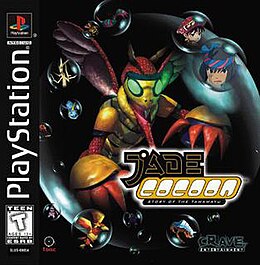| Jade Cocoon: Story of the Tamamayu 玉繭物語 | |
|---|---|
 | |
| Developer(s) | Genki |
| Publisher(s) | JP Genki NA Crave Entertainment PAL Crave, Ubisoft |
| Distributor(s) | Genki |
| Composer(s) | Kimitaka Matsumae |
| Platform(s) | PlayStation, PlayStation Network |
| Release date(s) | PlayStation JP 1998-12-03 NA 1999-07-29 PAL 1999 (Crave) JP 1999-09-14 (PlayStation the Best) PAL 2001-04-27 (Ubisoft eXclusive) JP 2002-02-07 (PSOne Books) PlayStation Network JP 2008-06-11 |
| Genre(s) | Adventure, RPG |
| Mode(s) | Single-player, multiplayer |
| Rating(s) | CERO: A (All ages) ESRB: Teen (13+) USK: 12+ |
| Media | 1 CD-ROM |
| Input methods | PlayStation controlle |
Gameplay
Jade Cocoon is set in a world where most of the land is covered in dense forest; populated by bizarre, mostly bug-like monsters called Minions. The only safe havens are small villages, one of which is the home of the protagonist, Levant. Levant is a young Cocoon Master, whose job is to capture and purify the Minions. The Minions can then be used to fight and defend Levant, spun into silk for money, or fused with other Minions to form more powerful combinations. Fused minions take on physical characteristics of both its parent creatures, allowing the player to customize the appearance of each one, as well as its abilities. Each minion has a collection of elemental attacks which can be passed from generation to generation. Strategy generally follows a rock/paper/scissors pattern (Wind beats Earth beats Water beats Fire beats Wind), as each wild Minion has an element (although fused Minions may have more than one).The Eternal Corridor
After the main story is completed, the player may continue to play the game in a new area called The Eternal Corridor. New monsters that were unavailable in the main game can be found in this new area.[2]Plot
Jade Cocoon is the story of Levant, a young man who lives in the town of Syrus. You guide the silent protagonist on his quest to follow in his presumably dead father's footsteps to become a cocoon master. To do this, he must marry a Nagi woman, and is betrothed to a girl named Mahbu (voiced by Michelle Ruff). On the day of a large festival in Syrus, the village is attacked by demons known as the Onibubu, which cause many villagers to fall into an deep slumber. An elderly Nagi woman, Garai, repels the Onibubu using Nagi magic before their curse affects everyone.After a quick wedding ceremony, Levant is given the title of cocoon master and leaves to explore the surrounding forest to find an herb rumored to be able to lift the curse. He traverses 4 forests on his quest, the Beetle, Dragonfly, Spider, and Moth forests, which populated with a variety of monsters known as minions that Levant may capture into cocoons and tame. On his quest he meets many others, such as Koris, the Blue Cocoon Master, and Kikinak, who assist him in saving the people of the village.[3]
Development
Previews and demos
In April 1999, Jade Cocoon, still in its alpha stages, was previewed in Next Generation Magazine as part of its "NG Alphas" series.[4] The following months, Jade Cocoon was previewed in Game Informer magazine twice, in issues 73 and 75,[5][6] then reviewed after release in issue 76.[7] It was then reviewed in the September issue of NGM.[8]A playable demo disk of Jade Cocoon was included in the release of Shadow Madness, Crave's first game, two months before release.[9] A month later, the game was previewed in the 21st issue of Official U.S. PlayStation Magazine[10], then later reviewed in the 23rd issue,[11] and featured on the issue's demo disk[12] along with demos for Final Fantasy VIII, 3Xtreme, Tiny Tank, Macross VF-2, Centipede, You Don't Know Jack, and Ultimate 8-Ball.[13] A few months later, it was also reviewed in the 53rd issue of Official UK PlayStation Magazine,[14] and featured on its demo disk.[15]
Re-releases
Jade Cocoon was re-released in Japan as part of the PlayStation the Best series in 1999, and again in 2002 as part of PSOne Books. In Europe, it was republished as a Ubisoft exclusive in 2001.[1] It was later released on the PlayStation Network for the PlayStation 3 and PlayStation Portable in June 2008 in Japan, but not in other regions.[16] It was released the same day as Crash Team Racing and other games.[17]Sequels
A mobile phone direct sequel was released in 1999 in Japan entitled Jade Cocoon Gaiden (玉繭物語 外伝 Tamamayu Monogatari Gaiden, literally "The Story of the Jade Cocoon: Side Story"). It continues the story from the end of the game.[18] A sequel with similar gameplay mechanics, Jade Cocoon 2, was later released for the PlayStation 2 in 2001. The game takes place 100 years after the original, and differs from it with its improved graphics and revised plot.[19]Reception
| Reception | |
|---|---|
| Aggregate scores | |
| Aggregator | Score |
| GameRankings | 74.65%[20] |
| GameStats | 7.9/10[21] |
| Review scores | |
| Publication | Score |
| Game Informer | 8/10[7] |
| GameSpot | 7.9/10[22] |
| IGN | 8.1/10[2] |
| Official PlayStation Magazine (US) | |
| Official PlayStation Magazine (UK) | 6 out of 10[14] |
| Absolute PlayStation | 81%[23] |
| Jeuxvideo.com | 17/20[24] |
| Next Generation Magazine | |
| PSi | 97%[25] |
| RPGFan | 78%[3] |
No comments:
Post a Comment